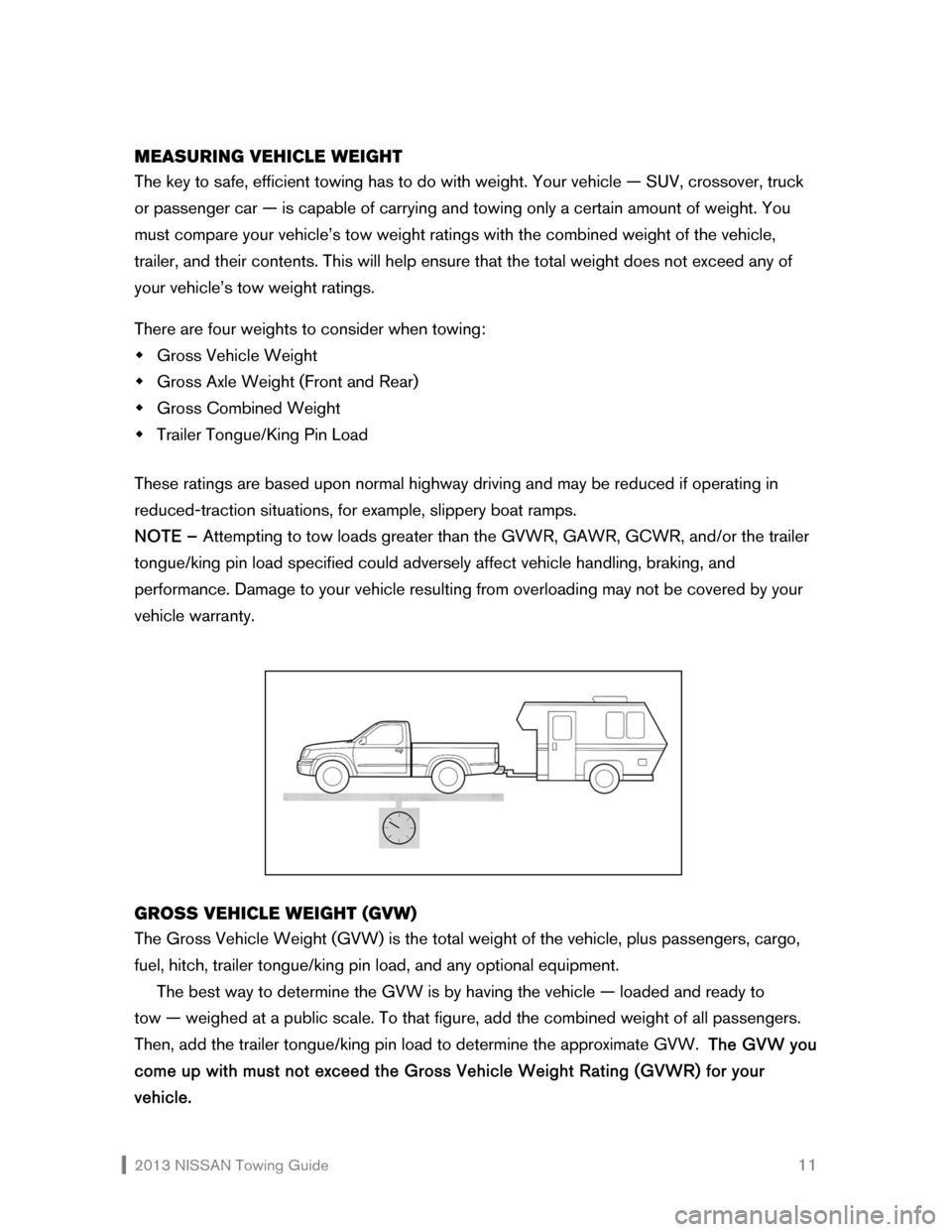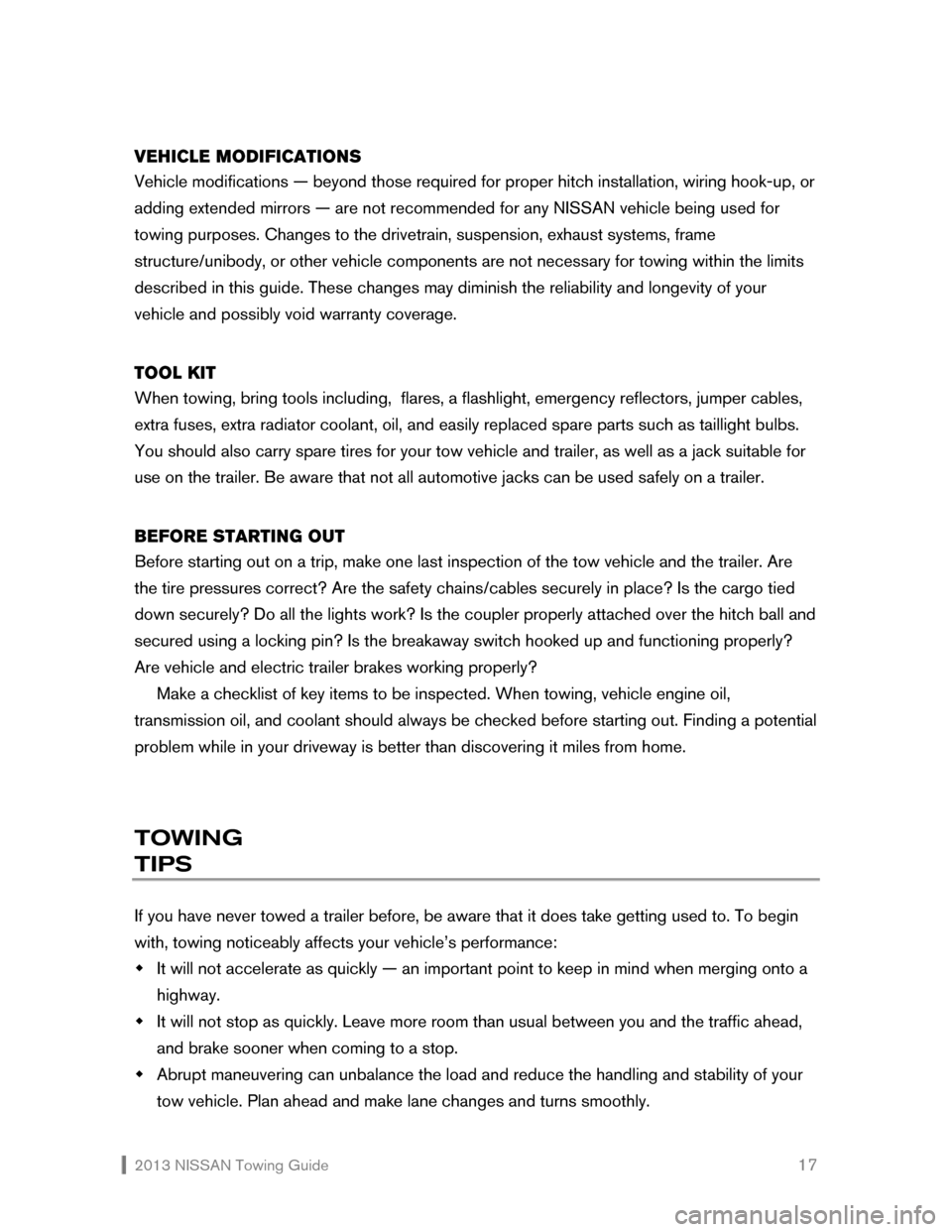key NISSAN GT-R 2013 R35 Towing Guide
[x] Cancel search | Manufacturer: NISSAN, Model Year: 2013, Model line: GT-R, Model: NISSAN GT-R 2013 R35Pages: 27, PDF Size: 0.49 MB
Page 12 of 27

2013 NISSAN Towing Guide 11 MEASURING VEHICLE WEIGHT
The key to safe, efficient towing has to do with weight. Your vehicle — SUV, crossover, truck
or passenger car — is capable of carrying and towing only a certain amount of weight. You
must compare your vehicle’s tow weight ratings with the combined weight of the vehicle,
trailer, and their contents. This will help ensure that the total weight does not exceed any of
your vehicle’s tow weight ratings.
There are four weights to consider when towing:
�Š Gross Vehicle Weight
�Š Gross Axle Weight (Front and Rear)
�Š Gross Combined Weight
�Š Trailer Tongue/King Pin Load
These ratings are based upon normal highway driving and may be reduced if operating in
reduced-traction situations, for example, slippery boat ramps.
NOTE – Attempting to tow loads greater than the GVWR, GAWR, GCWR, and/or the trailer
tongue/king pin load specified could adversely affect vehicle handling, braking, and
performance. Damage to your vehicle resulting from overloading may not be covered by your
vehicle warranty.
GROSS VEHICLE WEIGHT (GVW)
The Gross Vehicle Weight (GVW) is the total weight of the vehicle, plus passengers, cargo,
fuel, hitch, trailer tongue/king pin load, and any optional equipment.
The best way to determine the GVW is by having the vehicle — loaded and ready to
tow — weighed at a public scale. To that figure, add the combined weight of all passengers.
Then, add the trailer tongue/king pin load to determine the approximate GVW. The GVW you
come up with must not exceed the Gross Vehicle Weight Rating (GVWR) for your
vehicle.
Page 18 of 27

2013 NISSAN Towing Guide 17 VEHICLE MODIFICATIONS
Vehicle modifications — beyond those required for proper hitch installation, wiring hook-up, or
adding extended mirrors — are not recommended for any NISSAN vehicle being used for
towing purposes. Changes to the drivetrain, suspension, exhaust systems, frame
structure/unibody, or other vehicle components are not necessary for towing within the limits
described in this guide. These changes may diminish the reliability and longevity of your
vehicle and possibly void warranty coverage.
TOOL KIT
When towing, bring tools including, flares, a flashlight, emergency reflectors, jumper cables,
extra fuses, extra radiator coolant, oil, and easily replaced spare parts such as taillight bulbs.
You should also carry spare tires for your tow vehicle and trailer, as well as a jack suitable for
use on the trailer. Be aware that not all automotive jacks can be used safely on a trailer.
BEFORE STARTING OUT
Before starting out on a trip, make one last inspection of the tow vehicle and the trailer. Are
the tire pressures correct? Are the safety chains/cables securely in place? Is the cargo tied
down securely? Do all the lights work? Is the coupler properly attached over the hitch ball and
secured using a locking pin? Is the breakaway switch hooked up and functioning properly?
Are vehicle and electric trailer brakes working properly?
Make a checklist of key items to be inspected. When towing, vehicle engine oil,
transmission oil, and coolant should always be checked before starting out. Finding a potential
problem while in your driveway is better than discovering it miles from home.
TOWING
TIPS
If you have never towed a trailer before, be aware that it does take getting used to. To begin
with, towing noticeably affects your vehicle’s performance:
�Š It will not accelerate as quickly — an important point to keep in mind when merging onto a
highway.
�Š It will not stop as quickly. Leave more room than usual between you and the traffic ahead,
and brake sooner when coming to a stop.
�Š Abrupt maneuvering can unbalance the load and reduce the handling and stability of your
tow vehicle. Plan ahead and make lane changes and turns smoothly.